Clinical Audit of Pressure Injuries in a Surgical Ward: SGH
VerifiedAdded on 2022/09/21
|11
|2468
|23
Project
AI Summary
This project presents a clinical audit of pressure injuries conducted in a surgical ward at Singapore General Hospital. The study aims to reduce the incidence of pressure injuries among patients, particularly the elderly, who are more susceptible due to comorbidities and poor skin integrity. The audit outlines the causes of pressure injuries, including prolonged pressure on the skin, and details the stages of injury development. The project's objectives include implementing preventive measures like 2-hourly turning, covering bony areas, and using specialized beds. The audit methodology involves data collection through patient interaction, observation, and medical record review. The findings reveal the prevalence of pressure injuries, common locations, and the impact of care plans. The project recommends educating people about pressure injury prevention and early medical intervention for those at risk. The project also highlights the significance of clinical audits in healthcare settings for improving patient outcomes and adhering to medical standards of practice. The audit covers the project design, audit method, duration, population, sample size, recruitment, data storage, and data analysis to provide a comprehensive understanding of pressure injury management.
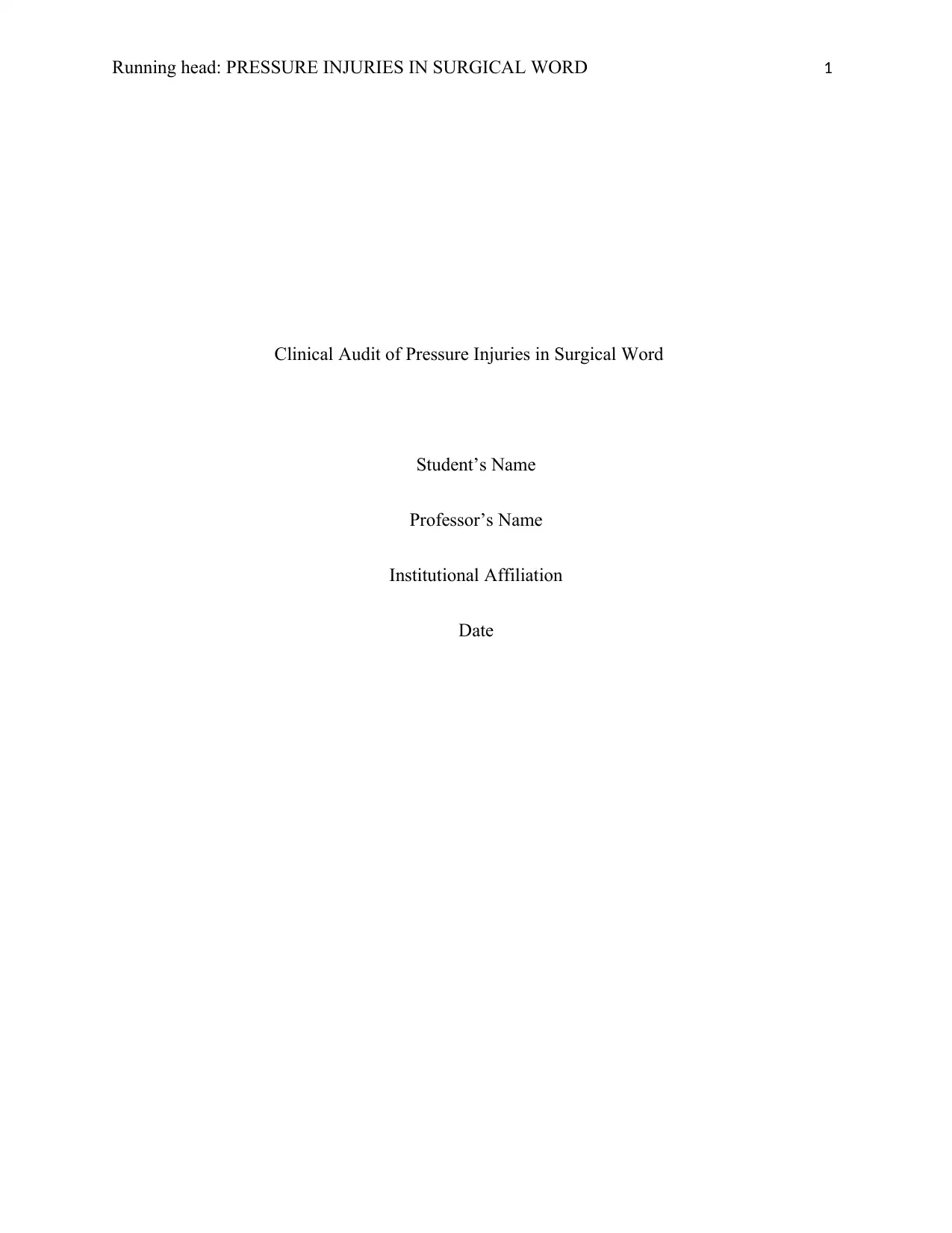
Running head: PRESSURE INJURIES IN SURGICAL WORD 1
Clinical Audit of Pressure Injuries in Surgical Word
Student’s Name
Professor’s Name
Institutional Affiliation
Date
Clinical Audit of Pressure Injuries in Surgical Word
Student’s Name
Professor’s Name
Institutional Affiliation
Date
Paraphrase This Document
Need a fresh take? Get an instant paraphrase of this document with our AI Paraphraser
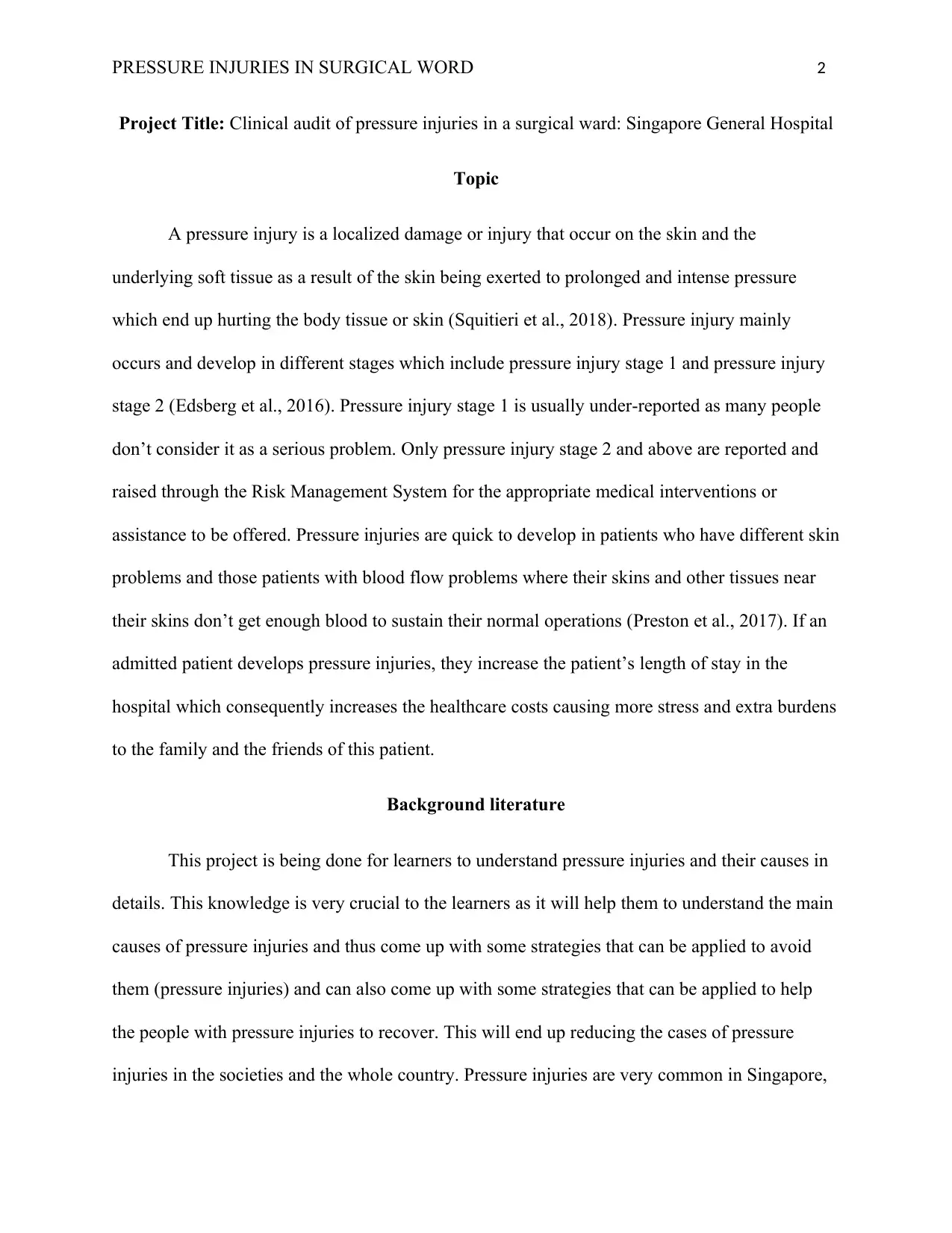
PRESSURE INJURIES IN SURGICAL WORD 2
Project Title: Clinical audit of pressure injuries in a surgical ward: Singapore General Hospital
Topic
A pressure injury is a localized damage or injury that occur on the skin and the
underlying soft tissue as a result of the skin being exerted to prolonged and intense pressure
which end up hurting the body tissue or skin (Squitieri et al., 2018). Pressure injury mainly
occurs and develop in different stages which include pressure injury stage 1 and pressure injury
stage 2 (Edsberg et al., 2016). Pressure injury stage 1 is usually under-reported as many people
don’t consider it as a serious problem. Only pressure injury stage 2 and above are reported and
raised through the Risk Management System for the appropriate medical interventions or
assistance to be offered. Pressure injuries are quick to develop in patients who have different skin
problems and those patients with blood flow problems where their skins and other tissues near
their skins don’t get enough blood to sustain their normal operations (Preston et al., 2017). If an
admitted patient develops pressure injuries, they increase the patient’s length of stay in the
hospital which consequently increases the healthcare costs causing more stress and extra burdens
to the family and the friends of this patient.
Background literature
This project is being done for learners to understand pressure injuries and their causes in
details. This knowledge is very crucial to the learners as it will help them to understand the main
causes of pressure injuries and thus come up with some strategies that can be applied to avoid
them (pressure injuries) and can also come up with some strategies that can be applied to help
the people with pressure injuries to recover. This will end up reducing the cases of pressure
injuries in the societies and the whole country. Pressure injuries are very common in Singapore,
Project Title: Clinical audit of pressure injuries in a surgical ward: Singapore General Hospital
Topic
A pressure injury is a localized damage or injury that occur on the skin and the
underlying soft tissue as a result of the skin being exerted to prolonged and intense pressure
which end up hurting the body tissue or skin (Squitieri et al., 2018). Pressure injury mainly
occurs and develop in different stages which include pressure injury stage 1 and pressure injury
stage 2 (Edsberg et al., 2016). Pressure injury stage 1 is usually under-reported as many people
don’t consider it as a serious problem. Only pressure injury stage 2 and above are reported and
raised through the Risk Management System for the appropriate medical interventions or
assistance to be offered. Pressure injuries are quick to develop in patients who have different skin
problems and those patients with blood flow problems where their skins and other tissues near
their skins don’t get enough blood to sustain their normal operations (Preston et al., 2017). If an
admitted patient develops pressure injuries, they increase the patient’s length of stay in the
hospital which consequently increases the healthcare costs causing more stress and extra burdens
to the family and the friends of this patient.
Background literature
This project is being done for learners to understand pressure injuries and their causes in
details. This knowledge is very crucial to the learners as it will help them to understand the main
causes of pressure injuries and thus come up with some strategies that can be applied to avoid
them (pressure injuries) and can also come up with some strategies that can be applied to help
the people with pressure injuries to recover. This will end up reducing the cases of pressure
injuries in the societies and the whole country. Pressure injuries are very common in Singapore,
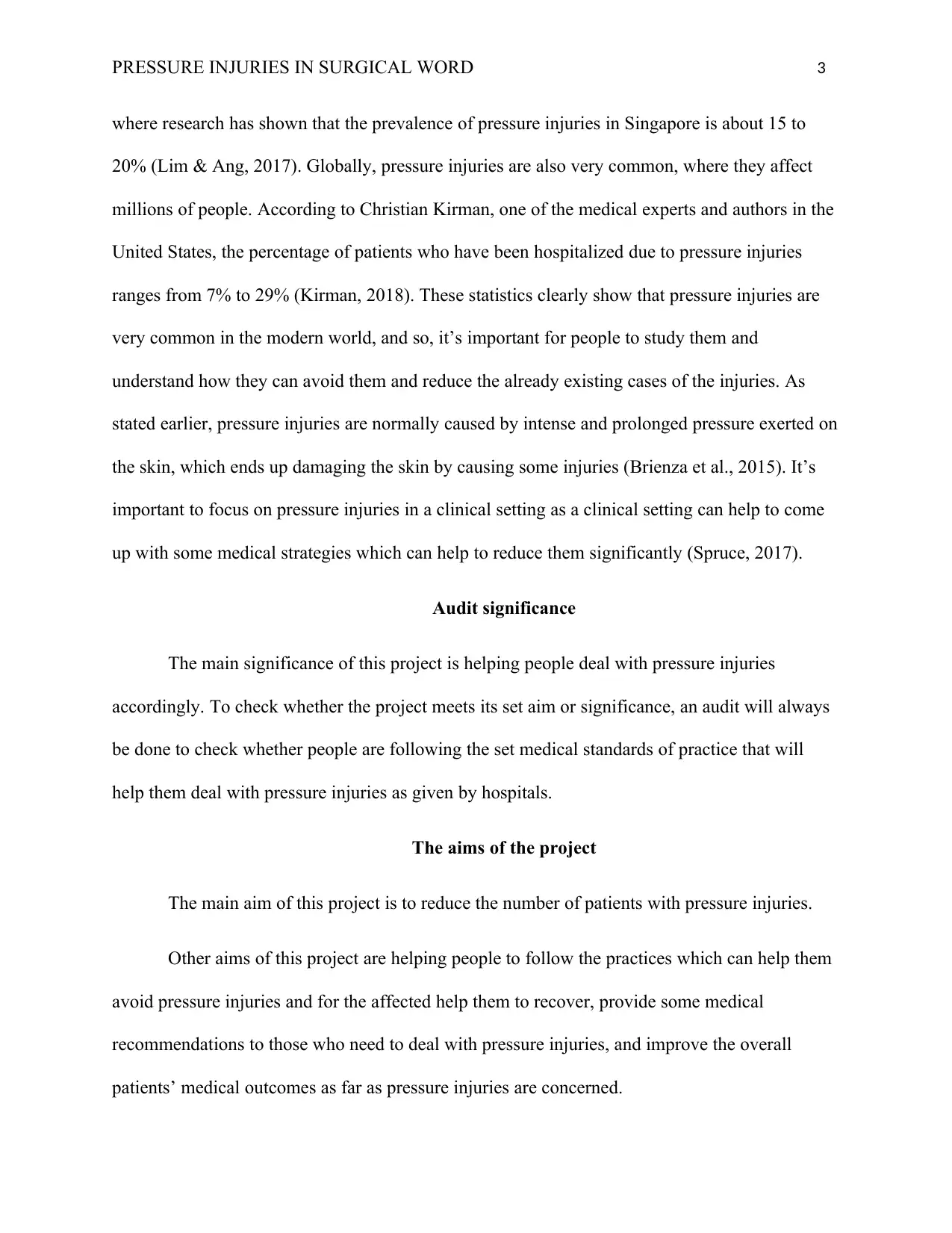
PRESSURE INJURIES IN SURGICAL WORD 3
where research has shown that the prevalence of pressure injuries in Singapore is about 15 to
20% (Lim & Ang, 2017). Globally, pressure injuries are also very common, where they affect
millions of people. According to Christian Kirman, one of the medical experts and authors in the
United States, the percentage of patients who have been hospitalized due to pressure injuries
ranges from 7% to 29% (Kirman, 2018). These statistics clearly show that pressure injuries are
very common in the modern world, and so, it’s important for people to study them and
understand how they can avoid them and reduce the already existing cases of the injuries. As
stated earlier, pressure injuries are normally caused by intense and prolonged pressure exerted on
the skin, which ends up damaging the skin by causing some injuries (Brienza et al., 2015). It’s
important to focus on pressure injuries in a clinical setting as a clinical setting can help to come
up with some medical strategies which can help to reduce them significantly (Spruce, 2017).
Audit significance
The main significance of this project is helping people deal with pressure injuries
accordingly. To check whether the project meets its set aim or significance, an audit will always
be done to check whether people are following the set medical standards of practice that will
help them deal with pressure injuries as given by hospitals.
The aims of the project
The main aim of this project is to reduce the number of patients with pressure injuries.
Other aims of this project are helping people to follow the practices which can help them
avoid pressure injuries and for the affected help them to recover, provide some medical
recommendations to those who need to deal with pressure injuries, and improve the overall
patients’ medical outcomes as far as pressure injuries are concerned.
where research has shown that the prevalence of pressure injuries in Singapore is about 15 to
20% (Lim & Ang, 2017). Globally, pressure injuries are also very common, where they affect
millions of people. According to Christian Kirman, one of the medical experts and authors in the
United States, the percentage of patients who have been hospitalized due to pressure injuries
ranges from 7% to 29% (Kirman, 2018). These statistics clearly show that pressure injuries are
very common in the modern world, and so, it’s important for people to study them and
understand how they can avoid them and reduce the already existing cases of the injuries. As
stated earlier, pressure injuries are normally caused by intense and prolonged pressure exerted on
the skin, which ends up damaging the skin by causing some injuries (Brienza et al., 2015). It’s
important to focus on pressure injuries in a clinical setting as a clinical setting can help to come
up with some medical strategies which can help to reduce them significantly (Spruce, 2017).
Audit significance
The main significance of this project is helping people deal with pressure injuries
accordingly. To check whether the project meets its set aim or significance, an audit will always
be done to check whether people are following the set medical standards of practice that will
help them deal with pressure injuries as given by hospitals.
The aims of the project
The main aim of this project is to reduce the number of patients with pressure injuries.
Other aims of this project are helping people to follow the practices which can help them
avoid pressure injuries and for the affected help them to recover, provide some medical
recommendations to those who need to deal with pressure injuries, and improve the overall
patients’ medical outcomes as far as pressure injuries are concerned.
⊘ This is a preview!⊘
Do you want full access?
Subscribe today to unlock all pages.

Trusted by 1+ million students worldwide
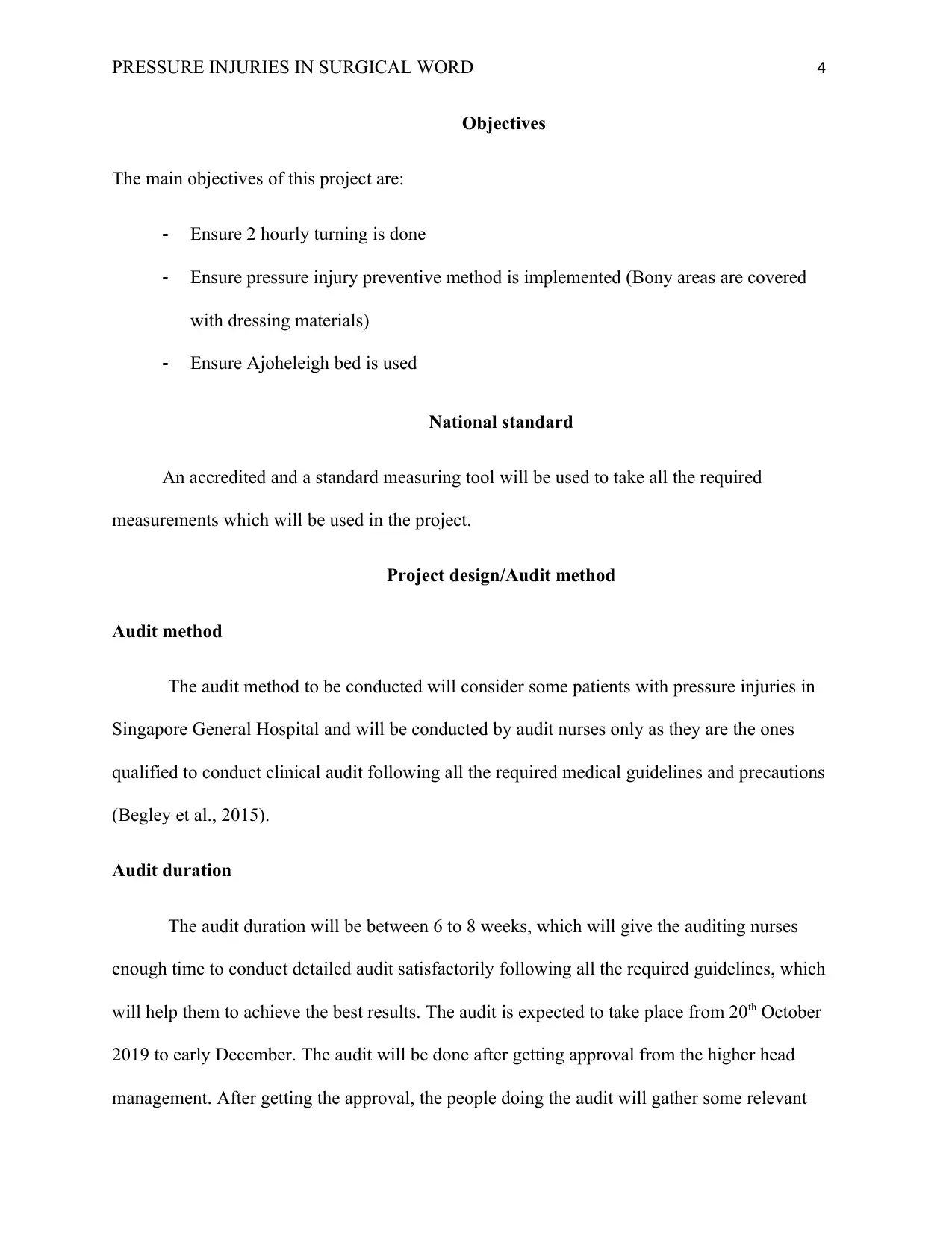
PRESSURE INJURIES IN SURGICAL WORD 4
Objectives
The main objectives of this project are:
- Ensure 2 hourly turning is done
- Ensure pressure injury preventive method is implemented (Bony areas are covered
with dressing materials)
- Ensure Ajoheleigh bed is used
National standard
An accredited and a standard measuring tool will be used to take all the required
measurements which will be used in the project.
Project design/Audit method
Audit method
The audit method to be conducted will consider some patients with pressure injuries in
Singapore General Hospital and will be conducted by audit nurses only as they are the ones
qualified to conduct clinical audit following all the required medical guidelines and precautions
(Begley et al., 2015).
Audit duration
The audit duration will be between 6 to 8 weeks, which will give the auditing nurses
enough time to conduct detailed audit satisfactorily following all the required guidelines, which
will help them to achieve the best results. The audit is expected to take place from 20th October
2019 to early December. The audit will be done after getting approval from the higher head
management. After getting the approval, the people doing the audit will gather some relevant
Objectives
The main objectives of this project are:
- Ensure 2 hourly turning is done
- Ensure pressure injury preventive method is implemented (Bony areas are covered
with dressing materials)
- Ensure Ajoheleigh bed is used
National standard
An accredited and a standard measuring tool will be used to take all the required
measurements which will be used in the project.
Project design/Audit method
Audit method
The audit method to be conducted will consider some patients with pressure injuries in
Singapore General Hospital and will be conducted by audit nurses only as they are the ones
qualified to conduct clinical audit following all the required medical guidelines and precautions
(Begley et al., 2015).
Audit duration
The audit duration will be between 6 to 8 weeks, which will give the auditing nurses
enough time to conduct detailed audit satisfactorily following all the required guidelines, which
will help them to achieve the best results. The audit is expected to take place from 20th October
2019 to early December. The audit will be done after getting approval from the higher head
management. After getting the approval, the people doing the audit will gather some relevant
Paraphrase This Document
Need a fresh take? Get an instant paraphrase of this document with our AI Paraphraser
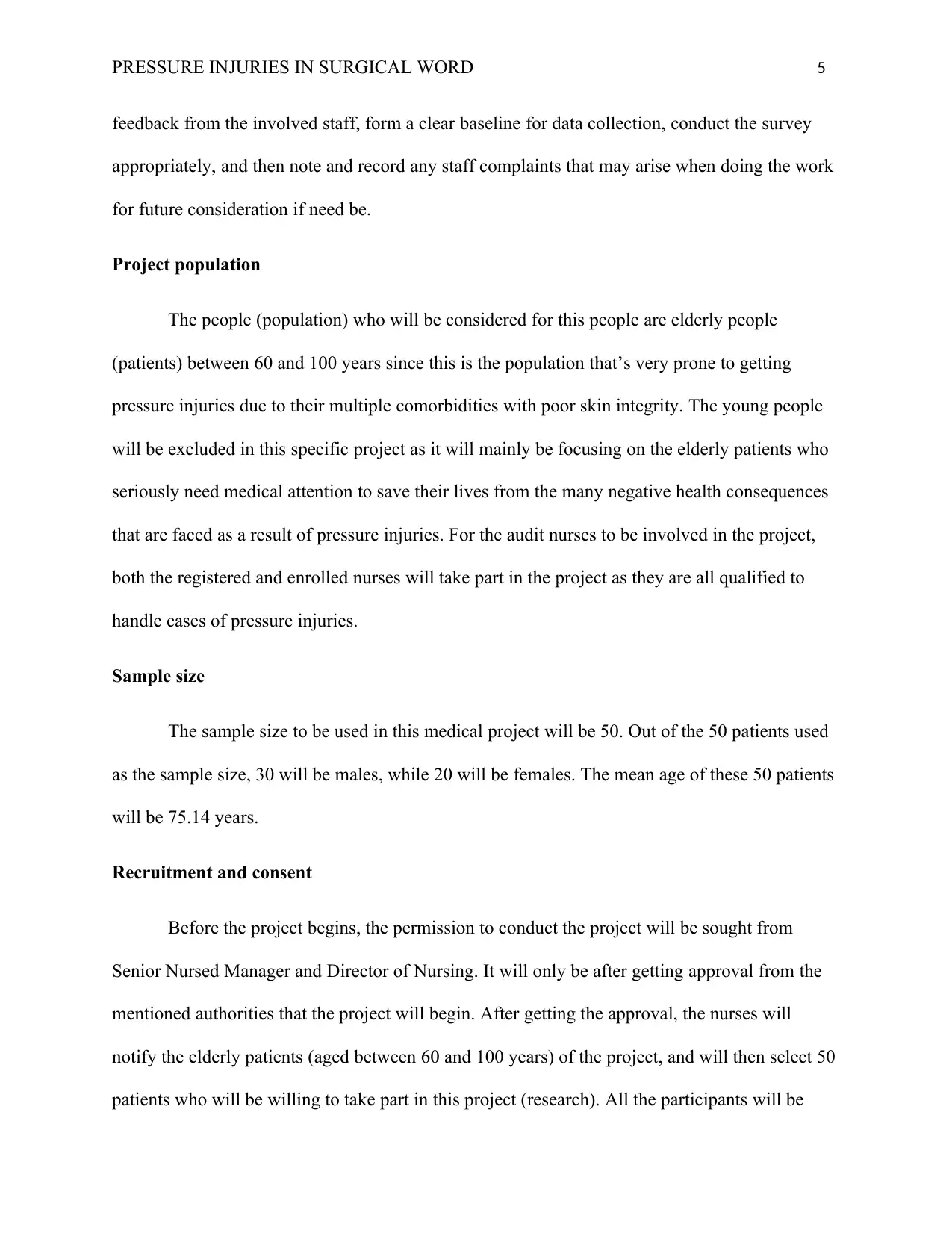
PRESSURE INJURIES IN SURGICAL WORD 5
feedback from the involved staff, form a clear baseline for data collection, conduct the survey
appropriately, and then note and record any staff complaints that may arise when doing the work
for future consideration if need be.
Project population
The people (population) who will be considered for this people are elderly people
(patients) between 60 and 100 years since this is the population that’s very prone to getting
pressure injuries due to their multiple comorbidities with poor skin integrity. The young people
will be excluded in this specific project as it will mainly be focusing on the elderly patients who
seriously need medical attention to save their lives from the many negative health consequences
that are faced as a result of pressure injuries. For the audit nurses to be involved in the project,
both the registered and enrolled nurses will take part in the project as they are all qualified to
handle cases of pressure injuries.
Sample size
The sample size to be used in this medical project will be 50. Out of the 50 patients used
as the sample size, 30 will be males, while 20 will be females. The mean age of these 50 patients
will be 75.14 years.
Recruitment and consent
Before the project begins, the permission to conduct the project will be sought from
Senior Nursed Manager and Director of Nursing. It will only be after getting approval from the
mentioned authorities that the project will begin. After getting the approval, the nurses will
notify the elderly patients (aged between 60 and 100 years) of the project, and will then select 50
patients who will be willing to take part in this project (research). All the participants will be
feedback from the involved staff, form a clear baseline for data collection, conduct the survey
appropriately, and then note and record any staff complaints that may arise when doing the work
for future consideration if need be.
Project population
The people (population) who will be considered for this people are elderly people
(patients) between 60 and 100 years since this is the population that’s very prone to getting
pressure injuries due to their multiple comorbidities with poor skin integrity. The young people
will be excluded in this specific project as it will mainly be focusing on the elderly patients who
seriously need medical attention to save their lives from the many negative health consequences
that are faced as a result of pressure injuries. For the audit nurses to be involved in the project,
both the registered and enrolled nurses will take part in the project as they are all qualified to
handle cases of pressure injuries.
Sample size
The sample size to be used in this medical project will be 50. Out of the 50 patients used
as the sample size, 30 will be males, while 20 will be females. The mean age of these 50 patients
will be 75.14 years.
Recruitment and consent
Before the project begins, the permission to conduct the project will be sought from
Senior Nursed Manager and Director of Nursing. It will only be after getting approval from the
mentioned authorities that the project will begin. After getting the approval, the nurses will
notify the elderly patients (aged between 60 and 100 years) of the project, and will then select 50
patients who will be willing to take part in this project (research). All the participants will be
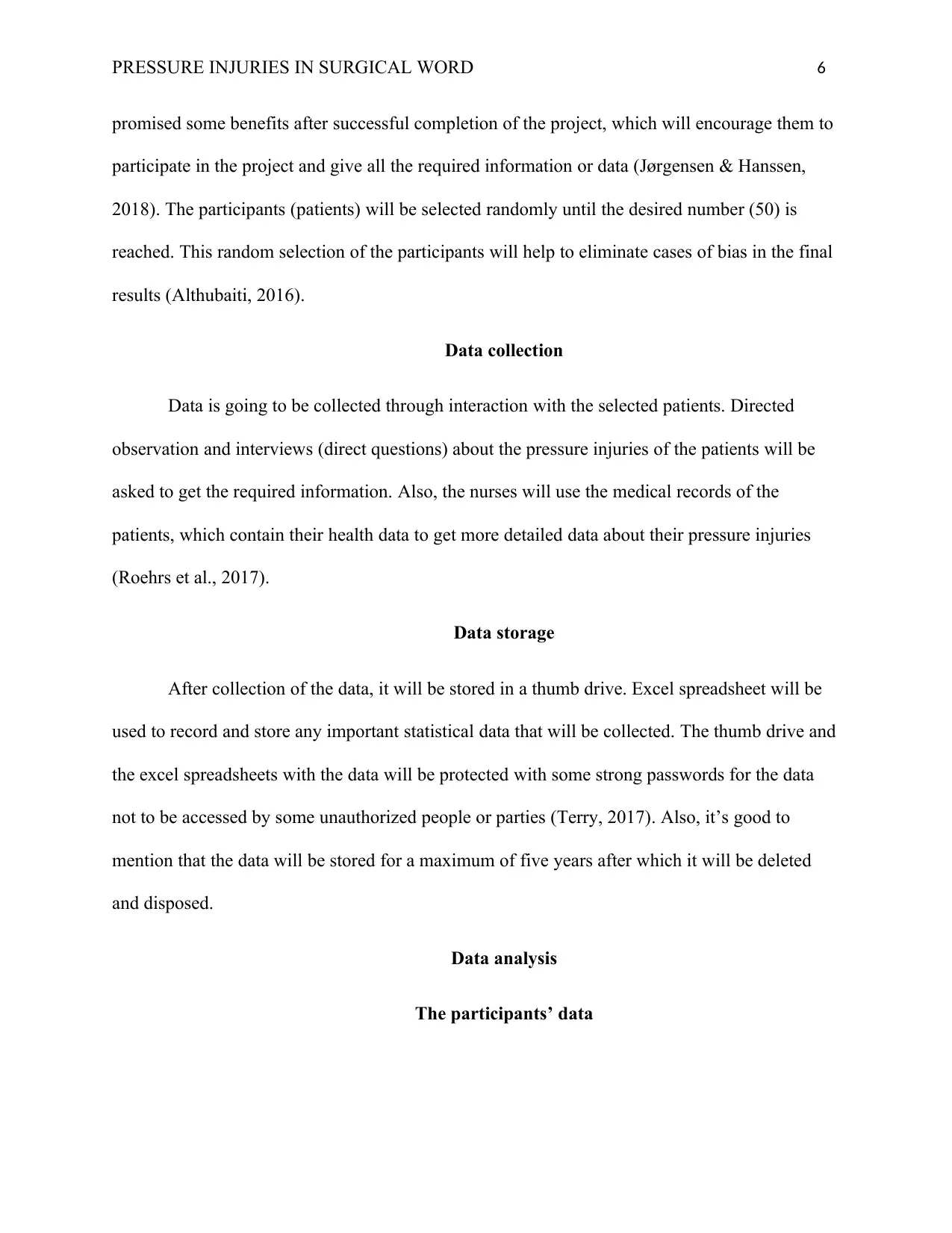
PRESSURE INJURIES IN SURGICAL WORD 6
promised some benefits after successful completion of the project, which will encourage them to
participate in the project and give all the required information or data (Jørgensen & Hanssen,
2018). The participants (patients) will be selected randomly until the desired number (50) is
reached. This random selection of the participants will help to eliminate cases of bias in the final
results (Althubaiti, 2016).
Data collection
Data is going to be collected through interaction with the selected patients. Directed
observation and interviews (direct questions) about the pressure injuries of the patients will be
asked to get the required information. Also, the nurses will use the medical records of the
patients, which contain their health data to get more detailed data about their pressure injuries
(Roehrs et al., 2017).
Data storage
After collection of the data, it will be stored in a thumb drive. Excel spreadsheet will be
used to record and store any important statistical data that will be collected. The thumb drive and
the excel spreadsheets with the data will be protected with some strong passwords for the data
not to be accessed by some unauthorized people or parties (Terry, 2017). Also, it’s good to
mention that the data will be stored for a maximum of five years after which it will be deleted
and disposed.
Data analysis
The participants’ data
promised some benefits after successful completion of the project, which will encourage them to
participate in the project and give all the required information or data (Jørgensen & Hanssen,
2018). The participants (patients) will be selected randomly until the desired number (50) is
reached. This random selection of the participants will help to eliminate cases of bias in the final
results (Althubaiti, 2016).
Data collection
Data is going to be collected through interaction with the selected patients. Directed
observation and interviews (direct questions) about the pressure injuries of the patients will be
asked to get the required information. Also, the nurses will use the medical records of the
patients, which contain their health data to get more detailed data about their pressure injuries
(Roehrs et al., 2017).
Data storage
After collection of the data, it will be stored in a thumb drive. Excel spreadsheet will be
used to record and store any important statistical data that will be collected. The thumb drive and
the excel spreadsheets with the data will be protected with some strong passwords for the data
not to be accessed by some unauthorized people or parties (Terry, 2017). Also, it’s good to
mention that the data will be stored for a maximum of five years after which it will be deleted
and disposed.
Data analysis
The participants’ data
⊘ This is a preview!⊘
Do you want full access?
Subscribe today to unlock all pages.

Trusted by 1+ million students worldwide
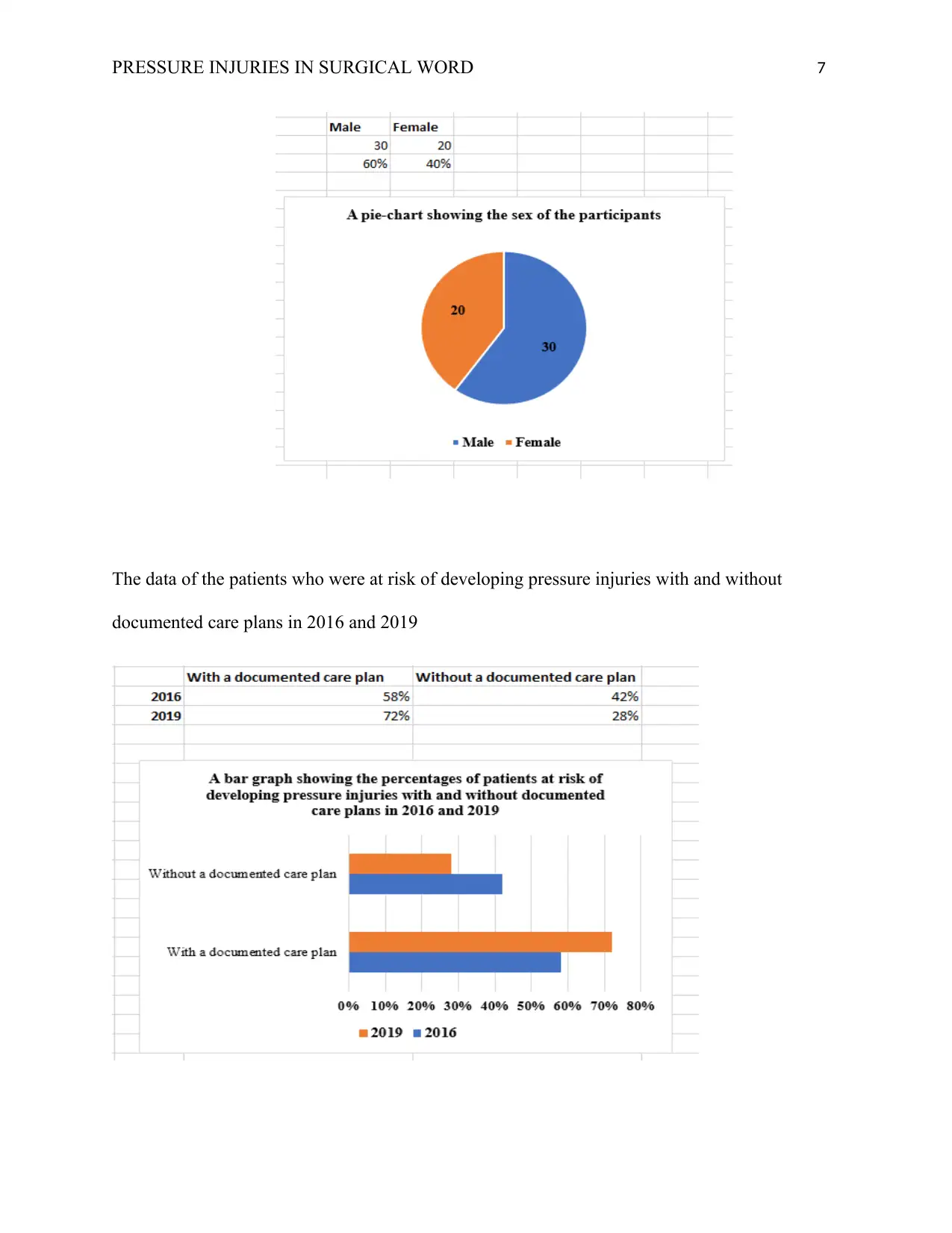
PRESSURE INJURIES IN SURGICAL WORD 7
The data of the patients who were at risk of developing pressure injuries with and without
documented care plans in 2016 and 2019
The data of the patients who were at risk of developing pressure injuries with and without
documented care plans in 2016 and 2019
Paraphrase This Document
Need a fresh take? Get an instant paraphrase of this document with our AI Paraphraser
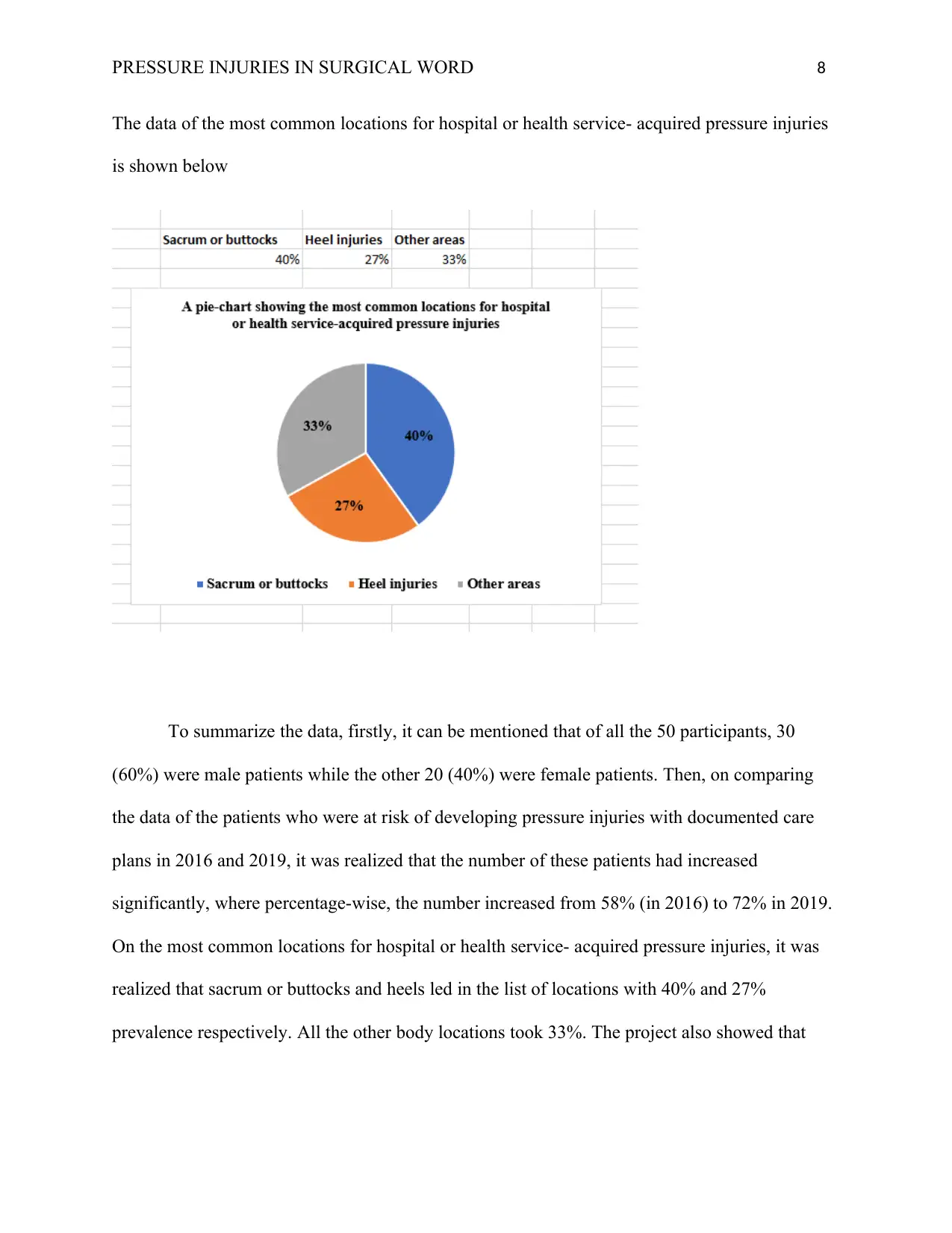
PRESSURE INJURIES IN SURGICAL WORD 8
The data of the most common locations for hospital or health service- acquired pressure injuries
is shown below
To summarize the data, firstly, it can be mentioned that of all the 50 participants, 30
(60%) were male patients while the other 20 (40%) were female patients. Then, on comparing
the data of the patients who were at risk of developing pressure injuries with documented care
plans in 2016 and 2019, it was realized that the number of these patients had increased
significantly, where percentage-wise, the number increased from 58% (in 2016) to 72% in 2019.
On the most common locations for hospital or health service- acquired pressure injuries, it was
realized that sacrum or buttocks and heels led in the list of locations with 40% and 27%
prevalence respectively. All the other body locations took 33%. The project also showed that
The data of the most common locations for hospital or health service- acquired pressure injuries
is shown below
To summarize the data, firstly, it can be mentioned that of all the 50 participants, 30
(60%) were male patients while the other 20 (40%) were female patients. Then, on comparing
the data of the patients who were at risk of developing pressure injuries with documented care
plans in 2016 and 2019, it was realized that the number of these patients had increased
significantly, where percentage-wise, the number increased from 58% (in 2016) to 72% in 2019.
On the most common locations for hospital or health service- acquired pressure injuries, it was
realized that sacrum or buttocks and heels led in the list of locations with 40% and 27%
prevalence respectively. All the other body locations took 33%. The project also showed that
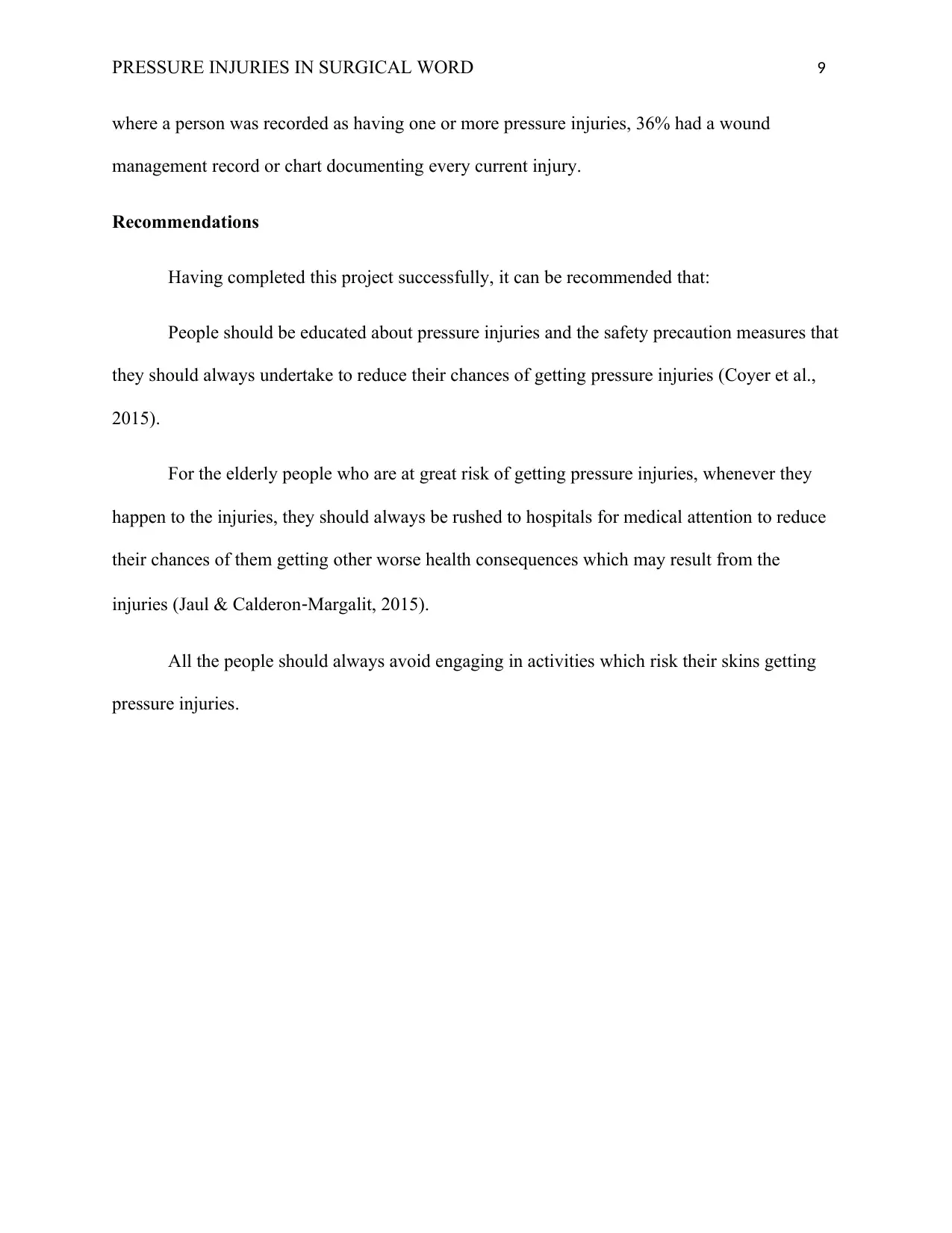
PRESSURE INJURIES IN SURGICAL WORD 9
where a person was recorded as having one or more pressure injuries, 36% had a wound
management record or chart documenting every current injury.
Recommendations
Having completed this project successfully, it can be recommended that:
People should be educated about pressure injuries and the safety precaution measures that
they should always undertake to reduce their chances of getting pressure injuries (Coyer et al.,
2015).
For the elderly people who are at great risk of getting pressure injuries, whenever they
happen to the injuries, they should always be rushed to hospitals for medical attention to reduce
their chances of them getting other worse health consequences which may result from the
injuries (Jaul & Calderon‐Margalit, 2015).
All the people should always avoid engaging in activities which risk their skins getting
pressure injuries.
where a person was recorded as having one or more pressure injuries, 36% had a wound
management record or chart documenting every current injury.
Recommendations
Having completed this project successfully, it can be recommended that:
People should be educated about pressure injuries and the safety precaution measures that
they should always undertake to reduce their chances of getting pressure injuries (Coyer et al.,
2015).
For the elderly people who are at great risk of getting pressure injuries, whenever they
happen to the injuries, they should always be rushed to hospitals for medical attention to reduce
their chances of them getting other worse health consequences which may result from the
injuries (Jaul & Calderon‐Margalit, 2015).
All the people should always avoid engaging in activities which risk their skins getting
pressure injuries.
⊘ This is a preview!⊘
Do you want full access?
Subscribe today to unlock all pages.

Trusted by 1+ million students worldwide
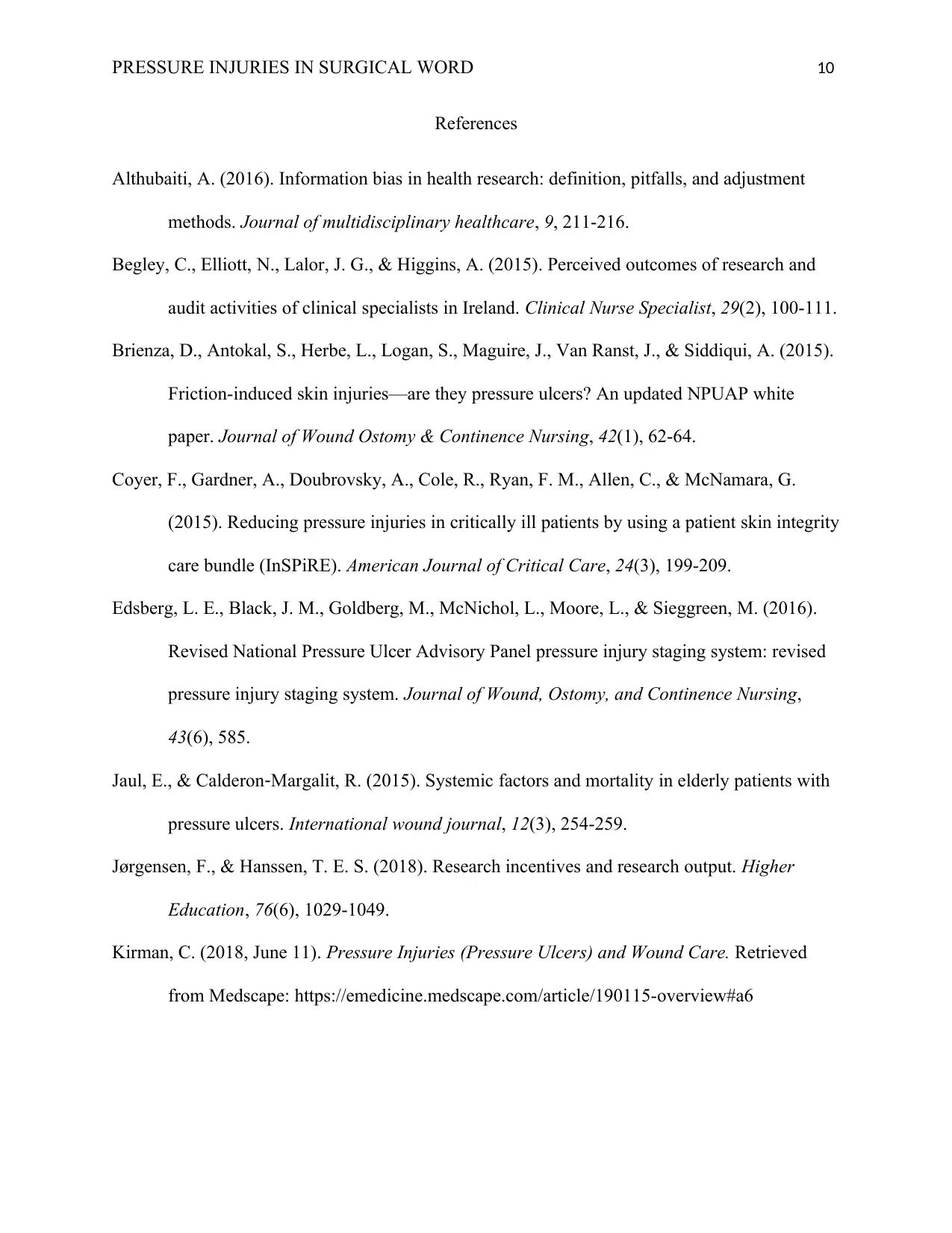
PRESSURE INJURIES IN SURGICAL WORD 10
References
Althubaiti, A. (2016). Information bias in health research: definition, pitfalls, and adjustment
methods. Journal of multidisciplinary healthcare, 9, 211-216.
Begley, C., Elliott, N., Lalor, J. G., & Higgins, A. (2015). Perceived outcomes of research and
audit activities of clinical specialists in Ireland. Clinical Nurse Specialist, 29(2), 100-111.
Brienza, D., Antokal, S., Herbe, L., Logan, S., Maguire, J., Van Ranst, J., & Siddiqui, A. (2015).
Friction-induced skin injuries—are they pressure ulcers? An updated NPUAP white
paper. Journal of Wound Ostomy & Continence Nursing, 42(1), 62-64.
Coyer, F., Gardner, A., Doubrovsky, A., Cole, R., Ryan, F. M., Allen, C., & McNamara, G.
(2015). Reducing pressure injuries in critically ill patients by using a patient skin integrity
care bundle (InSPiRE). American Journal of Critical Care, 24(3), 199-209.
Edsberg, L. E., Black, J. M., Goldberg, M., McNichol, L., Moore, L., & Sieggreen, M. (2016).
Revised National Pressure Ulcer Advisory Panel pressure injury staging system: revised
pressure injury staging system. Journal of Wound, Ostomy, and Continence Nursing,
43(6), 585.
Jaul, E., & Calderon‐Margalit, R. (2015). Systemic factors and mortality in elderly patients with
pressure ulcers. International wound journal, 12(3), 254-259.
Jørgensen, F., & Hanssen, T. E. S. (2018). Research incentives and research output. Higher
Education, 76(6), 1029-1049.
Kirman, C. (2018, June 11). Pressure Injuries (Pressure Ulcers) and Wound Care. Retrieved
from Medscape: https://emedicine.medscape.com/article/190115-overview#a6
References
Althubaiti, A. (2016). Information bias in health research: definition, pitfalls, and adjustment
methods. Journal of multidisciplinary healthcare, 9, 211-216.
Begley, C., Elliott, N., Lalor, J. G., & Higgins, A. (2015). Perceived outcomes of research and
audit activities of clinical specialists in Ireland. Clinical Nurse Specialist, 29(2), 100-111.
Brienza, D., Antokal, S., Herbe, L., Logan, S., Maguire, J., Van Ranst, J., & Siddiqui, A. (2015).
Friction-induced skin injuries—are they pressure ulcers? An updated NPUAP white
paper. Journal of Wound Ostomy & Continence Nursing, 42(1), 62-64.
Coyer, F., Gardner, A., Doubrovsky, A., Cole, R., Ryan, F. M., Allen, C., & McNamara, G.
(2015). Reducing pressure injuries in critically ill patients by using a patient skin integrity
care bundle (InSPiRE). American Journal of Critical Care, 24(3), 199-209.
Edsberg, L. E., Black, J. M., Goldberg, M., McNichol, L., Moore, L., & Sieggreen, M. (2016).
Revised National Pressure Ulcer Advisory Panel pressure injury staging system: revised
pressure injury staging system. Journal of Wound, Ostomy, and Continence Nursing,
43(6), 585.
Jaul, E., & Calderon‐Margalit, R. (2015). Systemic factors and mortality in elderly patients with
pressure ulcers. International wound journal, 12(3), 254-259.
Jørgensen, F., & Hanssen, T. E. S. (2018). Research incentives and research output. Higher
Education, 76(6), 1029-1049.
Kirman, C. (2018, June 11). Pressure Injuries (Pressure Ulcers) and Wound Care. Retrieved
from Medscape: https://emedicine.medscape.com/article/190115-overview#a6
Paraphrase This Document
Need a fresh take? Get an instant paraphrase of this document with our AI Paraphraser
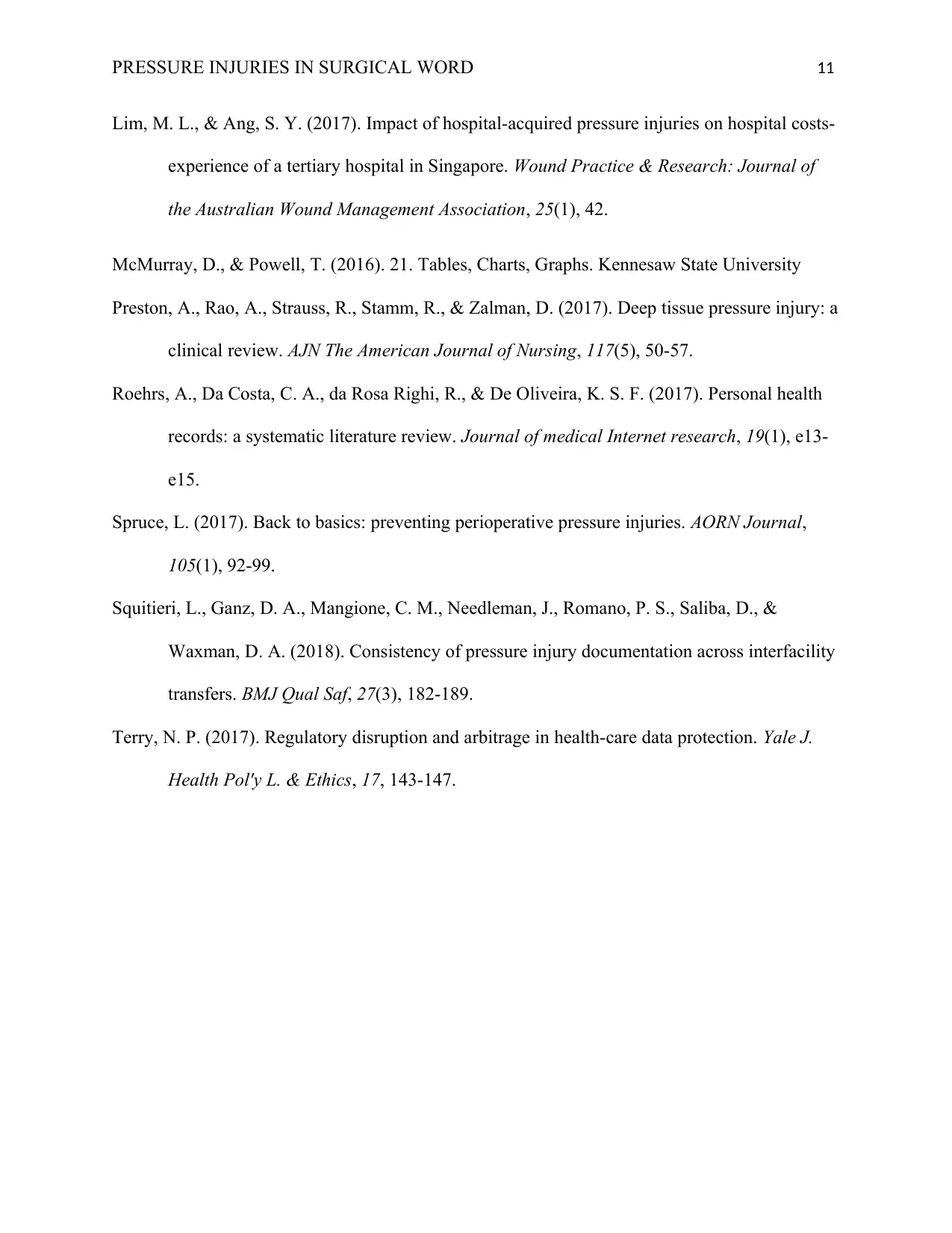
PRESSURE INJURIES IN SURGICAL WORD 11
Lim, M. L., & Ang, S. Y. (2017). Impact of hospital-acquired pressure injuries on hospital costs-
experience of a tertiary hospital in Singapore. Wound Practice & Research: Journal of
the Australian Wound Management Association, 25(1), 42.
McMurray, D., & Powell, T. (2016). 21. Tables, Charts, Graphs. Kennesaw State University
Preston, A., Rao, A., Strauss, R., Stamm, R., & Zalman, D. (2017). Deep tissue pressure injury: a
clinical review. AJN The American Journal of Nursing, 117(5), 50-57.
Roehrs, A., Da Costa, C. A., da Rosa Righi, R., & De Oliveira, K. S. F. (2017). Personal health
records: a systematic literature review. Journal of medical Internet research, 19(1), e13-
e15.
Spruce, L. (2017). Back to basics: preventing perioperative pressure injuries. AORN Journal,
105(1), 92-99.
Squitieri, L., Ganz, D. A., Mangione, C. M., Needleman, J., Romano, P. S., Saliba, D., &
Waxman, D. A. (2018). Consistency of pressure injury documentation across interfacility
transfers. BMJ Qual Saf, 27(3), 182-189.
Terry, N. P. (2017). Regulatory disruption and arbitrage in health-care data protection. Yale J.
Health Pol'y L. & Ethics, 17, 143-147.
Lim, M. L., & Ang, S. Y. (2017). Impact of hospital-acquired pressure injuries on hospital costs-
experience of a tertiary hospital in Singapore. Wound Practice & Research: Journal of
the Australian Wound Management Association, 25(1), 42.
McMurray, D., & Powell, T. (2016). 21. Tables, Charts, Graphs. Kennesaw State University
Preston, A., Rao, A., Strauss, R., Stamm, R., & Zalman, D. (2017). Deep tissue pressure injury: a
clinical review. AJN The American Journal of Nursing, 117(5), 50-57.
Roehrs, A., Da Costa, C. A., da Rosa Righi, R., & De Oliveira, K. S. F. (2017). Personal health
records: a systematic literature review. Journal of medical Internet research, 19(1), e13-
e15.
Spruce, L. (2017). Back to basics: preventing perioperative pressure injuries. AORN Journal,
105(1), 92-99.
Squitieri, L., Ganz, D. A., Mangione, C. M., Needleman, J., Romano, P. S., Saliba, D., &
Waxman, D. A. (2018). Consistency of pressure injury documentation across interfacility
transfers. BMJ Qual Saf, 27(3), 182-189.
Terry, N. P. (2017). Regulatory disruption and arbitrage in health-care data protection. Yale J.
Health Pol'y L. & Ethics, 17, 143-147.
1 out of 11
Related Documents
Your All-in-One AI-Powered Toolkit for Academic Success.
+13062052269
info@desklib.com
Available 24*7 on WhatsApp / Email
![[object Object]](/_next/static/media/star-bottom.7253800d.svg)
Unlock your academic potential
Copyright © 2020–2025 A2Z Services. All Rights Reserved. Developed and managed by ZUCOL.





